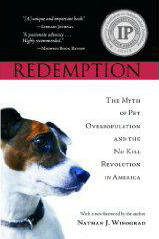 Some recent events regarding my animal shelter reform advocacy have led me back to the book which was a game changer for me. Redemption: The Myth of Pet Overpopulation and the No Kill Revolution in America by Nathan Winograd. The book was first published in 2007 (and has since been made into a documentary film). It changed my life when I read it in 2008 and learned about not only the history of the animal welfare movement (which began with Henry Bergh) but also about this wonderful thing called the No Kill equation. My copy looks like a used textbook with worn covers and highlighting. Nathan did not “invent” the No Kill programs and concepts so many of us live by today. What he did do was to analyze them and then present them in equation form for the very first time. He essentially created what I consider a blueprint for No Kill success in any place in the country. And therein lies the genius of the equation; we do not need Nathan Winograd to come to each of our communities and rescue us from ourselves. We need only learn about the No Kill equation, evaluate our existing resources and challenges, connect with those how have used the equation before us (in order to learn from their successes and mistakes) and then mold and shape the equation to fit the needs of the community. I believe in the equation because I know it works. I know people who are using it at this very minute and are saving the lives of countless animals in the process. In spite of the success of the programs and services of the equation, opposition still abounds. I should no longer be surprised by the toxicity of the opposition, but I am. As Nathan has said before, this is not just some clash of egos. People who either promote or oppose No Kill concepts and programs can’t just get in a room together and talk and hug it out and all just get along. While those who promote No Kill as an ideal and as a cultural norm champion saving lives, those who oppose No Kill as an ideal (or even say it is not possible, ala “the world is flat”) champion the status quo and do so at an incredibly high cost. Which leads me back to my point about Redemption. The afterword in the book talks about four groups of people who will oppose the concepts presented in the book. The observations about those groups are as relevant today as they were when Nathan wrote about them so many years ago and I’d like to share them with you, with Nathan’s permission, of course. Do you recognize any of this behavior? - The first group will agree with the message, be sympathetic to the cause, and want the same goal. Nonetheless, they will claim it ignores the success of others and focuses too much attention on San Francisco and later Tompkins County, communities in which [Nathan] played a significant role in drastically increasing the live release rate for shelter animals. (Making this observation more current, the first group will say that Austin, Texas, had to spend a lot of money [when in fact it became No Kill with no initial cost output)] that Huntsville, Alabama is "different" because of the progressive and diverse nature of the community, that there is no one on Earth quite like Doug Rae in Fremont County, Colorado and that compassionate leaders like him are hard to come by or that there must be something magical in the water in Lake County, Florida for it to become a No Kill community virtually overnight. - The second group that will take issue with the book are the animal activists who are intent on doing what they have always done, regardless of the facts. They will continue to blame the public and fight for more and tougher laws-once again buying into the false paradigm of pet overpopulation and public irresponsibility. They will argue that their community is different and that citizens in their community are particularly irresponsible. The evidence clearly shows that none of this is true. What is true is that shelters are filled with animals, in no small part because of a small segment of the public's throwaway attitudes about their pets. But that is why shelters exist in the first place. They are supposed to be the safety net for animals the same way orphanages and child protective services are the safety net for parentless and abused children. While people surrender animals to shelters it is the shelters that kill them, and one does not necessarily follow or excuse the other. -The third group of critics of the book will be the shelter directors themselves - those who are involved in the killing of [millions] of dogs and cats a year and who erroneously claim that doing so is both necessary and proper. They will see this book as nothing more than a personal attack. They will argue that we should all get along, not fight each other, and focus on our common enemy-the irresponsible public which fills shelters with discarded animals. This point of view is nothing more than a smokescreen and is contradicted by the facts.
-The fourth and final group of people who will criticize the book are a group I collectively call “the naysayers.” The naysayers are those who have a predetermined agenda of support for animal control, regardless of how many animals the local shelter kills or how otherwise dysfunctional the agency is. They cannot be swayed by logic, facts or alternative points of view. They seek out that which fits their beliefs and reject everything else to the point of taking facts out of context - and in some cases, making up “facts” - to fit the story. It is incredibly unfortunate that so many people expend so much time and energy fighting against programs which have been proven to save lives when fully implemented. Some of the most vocal and toxic opposition to animal shelter reform comes from people who claim to advocate for animals - which seems completely illogical. Because it is. I never cease to be amazed that people view free speech seeking better for shelter animals as "bashing" or an "attack." It is neither when it is done respectfully, diplomatically and it is focused on accountability and leadership (as opposed to being focused on specific people). As I have written before, a time will come when we no longer destroy savable pets in America. When that fine day comes, will you look back and know that you championed life? Or will you look back and regret all those hours and days and weeks and months you spent defending the killing because you were more focused on people than on animals? Or worse yet, because you would not speak your personal truth to save innocents when that is what the situation demanded of you.
0 Comments
Your comment will be posted after it is approved.
Leave a Reply. |
AuthorI am an animal welfare advocate. My goal is to help people understand some basic issues related to companion animals in America. Awareness leads to education leads to action leads to change. Archives
July 2024
Categories
All
image courtesy of Terrah Johnson
|


 RSS Feed
RSS Feed